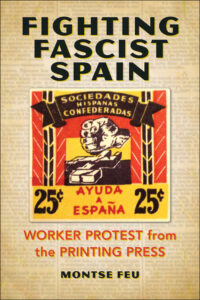Book Review Fighting Fascist Spain: Worker Protest from the Printing Press
 Fighting Fascist Spain: Worker Protest from the Printing Press, by Montse Feu. Urbana, Chicago and Springfield: University of Illinois Press, 2020. 278 pp.
Fighting Fascist Spain: Worker Protest from the Printing Press, by Montse Feu. Urbana, Chicago and Springfield: University of Illinois Press, 2020. 278 pp.
In her new book, Montse Feu examines España Libre, a Spanish-language journal associated with the Spanish anarchist movement that was published in the United States from 1939 until 1975. Emerging at the end of the Popular Front era from the fractures and new alliances formed in the wake of the defeat of the Spanish Republic, España Libre is a rich source for understanding the doctrinal disputes within the movement, its international influence, and the complicated world of Cold War politics. The journal itself, for example, was born out of another periodical, Frente Popular, published by the US-based Comité Antifascista Español (CAE). Shortly before the conflict between communist and anti-Stalinist factions that would break up the Spanish refugee-aid movement, the CAE became the Sociedades Hispanas Confederadas (SHC) and its journal was renamed España Libre. A brief recounting of that history appears in chapter three.
Feu tells a story not only of fracture and weakening influence but also of considerable reach and power. At its peak, the SHC had 65,000 members. Over the course of its existence, it raised $2 million in aid despite “chronic financial shortfalls” in the periodical’s own fiscal health. This aid was distributed to nearly 30 percent of its distressed exile and refugee readership.
Feu is interested in “the web of anarchist, anarcho-syndicalist, and socialist connections that facilitated the political engagement of local activists and organizations to enlarge the global reach of the organization” and in recovering “talented working-class authors and artists who were no longer invested in imminent revolutions but instead adapted to the demands of exile and the Cold War.” The first part of the book is historical and biographical in focus, while the second, shorter part centers on aesthetics and representations.
España Libre was anything but a marginal journal. For example, it frequently featured speeches and editorials from the members of the Republican government in exile (although the editors insisted on their editorial and organizational independence). The periodical was regularly smuggled into Franco’s Spain and, conversely, relied on sources on the inside to reveal the scale of the repression. Not surprisingly, the editors drew the attention of the FBI. They were also well connected to American political and intellectual circles. The SHC’s network of close associates included figures such as Nancy and Dwight Macdonald, Roger Nash Baldwin, Norman Thomas, and Rudolf Rocker. As Feu also uncovers, the US freedom rider James Peck was interested in protesting Franco’s Spain as much as he was fighting racial segregation in the American South.
As time moved on, the Cold War pushed some of the journal’s contributors into surprising directions. The novelist Ramón J. Sender, for example, ended up voicing support for the war in Vietnam. Feu also reveals that some of the journal’s contributors were what we would now call “undocumented.” The German anarchist Rudolf Rocker was worried about his possible deportation to Nazi Germany where he would face certain death.
Within the US public sphere, España Libre pushed back consistently against the attempts—from Spain but also from US intellectuals and politicians—to put a friendly face on the Franco regime. As Feu shows, the journal painstakingly documented the regime’s executions, acts of torture, and imprisonment of political dissidents. In the same spirit, one of Feu’s footnotes provides names of the pro-Franco US congressmen that España Libre attempted to rebuke.
Feu holds a strong interest in theater, and the book’s close to forty pages of appendices include an exhaustive list of “Original Antifascist and Exile Plays, 1937-1950,” most of which are lost. Feu also highlights the role played by women, who often assumed central functions in fundraising activities, although relatively few were involved in publishing España Libre.
For all its breadth, the book leaves some areas relatively underexplored. This reviewer would have been interested to read more about the effects of McCarthyism and FBI surveillance, for example. And while it is undoubtedly true that “[d]espite the ideological differences, as well as doctrinal confrontations among leaders and theorists, antifascist sentiment encouraged the confluence of socialist, republican, and anarchist militants,” I wondered about the political and ideological conflicts spurred by the Cold War. Did the support for Vietnam by some of its contributors foster discord? If so, how was it addressed?
Those questions notwithstanding, Feu’s book is an important contribution to the growing scholarship on refugees and relief aid in the wake of the Spanish war, as well as anarchism, radical literature, and the Spanish diaspora more generally. This book’s most important contribution, in fact, may be that it gives voice to those anarchists who are generally neglected in the larger narrative of the Spanish Civil War and its aftermath.
Eric Smith, author of American Relief Aid and the Spanish Civil War (University of Missouri Press, 2013), holds a Ph.D. from the University of Illinois at Chicago and is an instructor of history at the Illinois Mathematics and Science Academy.













Thank you Eric for your review. I agree that there is so much to continue exploring!